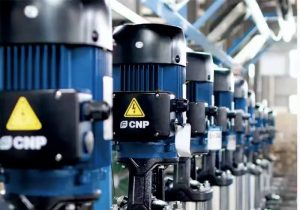The electric motor plays a vital role in today’s industries. It can efficiently and reliably drive a range of systems, such as conveyor belts and robotic arms for extended periods. The method used to initiate them greatly affects their performance, wear and tear, and overall efficiency. It is vital to choose the appropriate motor starting technique to ensure optimal performance while minimizing stress on the mechanical components involved. This piece delves into the various ways electric motors can be started, discussing their pros and cons while also highlighting Enneng’s cutting-edge offerings in permanent magnet synchronous motor technology.

The way an electric motor is initiated significantly affects its performance and lifespan. Electric motors typically encounter resistance when starting, which may result in wear and possible malfunctions if not handled correctly. Being familiar with the different starting methods enables informed choices that suit particular industrial needs.
Description: In the DOL starting method, the motor is directly connected to the power supply, applying full voltage to the motor terminals.
Advantages:
Simplicity: Easy to install and operate without complex circuitry.
Cost-Effectiveness: Typically lower initial costs compared to other methods.
Full Torque: Provides the motor with full starting torque, suitable for many low-power applications.
Disadvantages:
High Inrush Current: This causes a large surge in current that can affect the power network and may reduce the motor’s lifespan.
Mechanical Stress: The sudden application of full voltage can lead to mechanical stress on the motor and the equipment it drives.
Description: The motor initially starts in a star (Y) configuration, which reduces the voltage and current, then switches to a delta (Δ) configuration for normal operation.
Advantages:
Reduced Starting Current: Lower inrush current compared to DOL, which mitigates the impact on the power grid.
Less Mechanical Stress: Gradual increase in torque reduces mechanical stress during startup.
Disadvantages:
Complexity: More complex than DOL, requiring additional components and wiring.
Torque Dip: There may be a temporary reduction in torque during the transition from star to delta.
Description: This method uses an auto-transformer to reduce the voltage applied to the motor during startup. After the motor starts, it switches to full line voltage.
Advantages:
Controlled Start: More effective at reducing starting current than star-delta starters.
Adjustable Voltage: Different voltage taps allow for control over starting characteristics.
Disadvantages:
Higher Cost: More expensive than DOL and star-delta starters.
Size and Weight: Typically larger and heavier due to the auto-transformer.
Description: Soft starters gradually increase the voltage to the motor, using solid-state devices to control the voltage applied.
Advantages:
Smooth Start: Significantly reduces inrush current and mechanical stress.
Adjustability: Offers precise control over acceleration and deceleration, improving operational flexibility.
Disadvantages:
Heat Generation: Solid-state devices can generate significant heat, requiring proper heat dissipation measures.
Cost: More expensive than mechanical starters like DOL and star-delta.
Description: VFD systems regulate the speed of motors through adjustments, in frequency and voltage of the power source to allow for acceleration and deceleration processes.
Advantages:
Optimizing energy usage by adjusting the speed of the motor to meet the load demands leads to savings, in energy expenses.
Enables management of motor speed and power to adjust to varying load situations.
Ensuring a good performance helps lessen the strain, on the motors electrical components which ultimately extends its longevity.
Disadvantages:
Setting up and programming this would be more challenging. Might require training due, to its complexity.
Starting can be more expensive, at first requiring an investment than other options available.
Harmonics may be incorporated into the power system. This could necessitate the use of filtering equipment.
Enneng is a leading firm that focuses on designing and manufacturing magnet motors (PMSMs). Through a commitment, to creativity and customer-centric approaches Enneng has established itself as a contributor, in the field of electric motors. Below are some of the products and technologies offered by Enneng.

Description: These motors utilize permanent magnets for rotor excitation, leading to higher efficiency and performance compared to traditional induction motors.
Applications: Widely used in various industrial sectors, including automation, textiles, and HVAC systems, where energy efficiency is crucial.
Description: Enneng offers soft starters designed for permanent magnet synchronous motors, providing smooth startup capabilities.
Benefits: These soft starters help reduce mechanical stress, improve the operational stability of motors, and extend the life of the motor.
Variable Frequency Drives (VFDs)
Description: Enneng’s VFDs allow for advanced control of motor speed and torque, adapting to the specific requirements of different applications.
Description: Understanding that every industry has unique needs, Enneng provides tailored motor solutions that meet specific operational requirements.
Support: With a team of experienced engineers, Enneng ensures that customers receive effective solutions that enhance productivity and efficiency.
When deciding how to start a motor, it is important to consider the usage, power needs, and financial limitations. Below is a breakdown of the strategies discussed:
|
Starting Method |
Advantages |
Disadvantages |
|
DOL Starters |
Simple, cost-effective, full torque |
High inrush current, mechanical stress |
|
Star-Delta |
Reduced starting current, less mechanical stress |
Complexity, torque dip during transition |
|
Auto-Transformer |
Controlled start, adjustable voltage |
Higher cost, size and weight |
|
Soft Starters |
Smooth start, adjustable control |
Heat generation, higher cost |
|
VFDs |
Energy-efficient, precise control |
Complexity, higher initial cost, potential harmonics |
For improving efficiency and environmental reliability, choosing the best way to kick off motors is very important. Each method has its advantages and disadvantages. It is suitable for different scenarios. Enneng stands out in the field by offering high-quality PMSMs (Permanent Magnet Synchronous Motors) soft starters and VFDs (Variable Frequency Drives) as solutions that cater to needs. With a focus on innovation and performance, Enneng is well-prepared to meet the evolving demands in the electric motor industry.